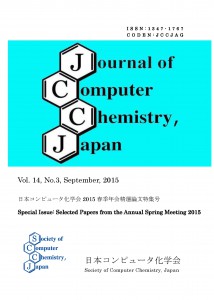 Journal of Computer Chemistry, Japan [No.2015-0025] Published online by J-STAGE
Journal of Computer Chemistry, Japan [No.2015-0025] Published online by J-STAGE<Title:> Calculation of NMR Shielding Constants with Optimized Numerical Basis Function
<Author(s):> Katsumi Nakagawa
<Corresponding author E-Mill:> nakagawa.katsumi(at)nifty.com<Abstract:> Isotropic NMR shielding constants σiso were calculated for hydrogen, carbon, nitrogen, oxygen, fluorine and phosphorous atoms in small molecules by using numerical basis functions, which were based on AOs of Discrete Variational Xα (DV-Xα) method and were modified to London atomic orbitals to avoid the gauge-origin-dependence when magnetic field exists. In DV-Xα method AOs are prepared by solving the Hartree-Fock-Slater (HFS) equation substantially equivalent to that used to calculate MOs and are very accurate around each nucleus. However, σisos calculated in the default condition of DV-Xα method don’t agree well to experimental ones. By optimizing AOs in a reasonable way, σisos were highly improved and agreed with experimental ones far better than results by Hartree-Fock (HF) method having conventional basis functions. The usefulness of MOs constructed with optimized numerical basis functions was clearly demonstrated.
<Keywords:> NMR shielding constant, Chemical shift, Basis function, DV-Xα method, London atomic orbital
<URL:> https://www.jstage.jst.go.jp/article/jccj/14/3/14_2015-0025/_article/-char/ja/